Classroom Scenario #1: Wested'S Center For Child and Family Studies, Desired Results T&Ta Project
Classroom Scenario #1: Wested'S Center For Child and Family Studies, Desired Results T&Ta Project
Uploaded by
Maritoni CañasCopyright:
Available Formats
Classroom Scenario #1: Wested'S Center For Child and Family Studies, Desired Results T&Ta Project
Classroom Scenario #1: Wested'S Center For Child and Family Studies, Desired Results T&Ta Project
Uploaded by
Maritoni CañasOriginal Title
Copyright
Available Formats
Share this document
Did you find this document useful?
Is this content inappropriate?
Copyright:
Available Formats
Classroom Scenario #1: Wested'S Center For Child and Family Studies, Desired Results T&Ta Project
Classroom Scenario #1: Wested'S Center For Child and Family Studies, Desired Results T&Ta Project
Uploaded by
Maritoni CañasCopyright:
Available Formats
Activity: Slide 48
Classroom Scenario #1
The children were engaged and attentive during morning circle. After
transitioning to center time however, the classroom began to fall apart. Two
children immediately went to the library to work on a puzzle. The rest of the
children wandered around the room without engaging in an activity. After 15
minutes, the noise level of the room rose when three children began to play a
chasing game. They accidentally scattered the puzzle pieces that two
children in the library were working on, and knocked over one of the easels.
Fortunately, no one was using it at the time.
While the teachers attended to the chaos, two children wandered into the
bathroom. They stuffed toilet paper into the sink drain and turned the
water on full force. By the time the teachers noticed, the floor was flooded
and the children were wet head-to-toe. When center time was almost over,
and it was time to transition outdoors, the room was in shambles.
Why might this scenario occur? How might you focus your observations to
evaluate the classroom?
What strategies would you suggest the teacher use in this situation?
Copyright © 2009 California Department of Education, Child Development Division with
WestEd’s Center for Child and Family Studies, Desired Results T&TA Project.
Activity: Slide 48
Classroom Scenario #2
Most of the day goes well. The children are engaged in the morning circle
time. The room is well organized and has many interesting activities and
props available in the various centers of the room. The teachers are
attentive, energetic, and engaged. They appear to have healthy, close
relationships with the children in their group.
Transition times however are chaotic. It takes almost ten minutes for the
teachers to gather and settle the children into morning circle. Later, when it
is time to clean up and go outside, the teachers struggle for almost 20
minutes to clean up the room, and make sure that all the children have their
shoes on and have used the bathroom.
The classroom serves lunch family-style. Some children sit down before
washing hands and are sent back to the sink. Others wash hands and then go
back to the home living area to play. While the two teachers are rounding up
wandering children, three other children sit at the table and using the
serving spoons, begin to eat directly out of the serving dishes.
After lunch, the nap time transition is also chaotic. While one teacher cleans
up the lunch tables, the other tries to help children get ready for nap, as
three children move their nap mats around the room. One child finally gets
on his nap mat, and in the next moment, he is up again playing with materials
from the shelves that had just been put away a few moments before.
Why might this scenario occur? How might you focus your observations to
evaluate the classroom?
What strategies would you suggest the teacher use in this situation?
Copyright © 2009 California Department of Education, Child Development Division with
WestEd’s Center for Child and Family Studies, Desired Results T&TA Project.
Activity: Slide 48
Copyright © 2009 California Department of Education, Child Development Division with
WestEd’s Center for Child and Family Studies, Desired Results T&TA Project.
Activity: Slide 48
Classroom Scenario #3
The morning begins at 8:30 a.m. with circle time. After a greeting song and a
10-minute show and tell, the teacher does a quick “beginning sound” activity,
an active dancing activity, and ends circle time with the teacher reading
aloud two picture books. During the final story activity, a number of children
leave the circle to use the bathroom or get a tissue. A few children take
some small toys from their pockets and begin to play with them. One child
takes off her shoes, puts them on her hands, and pretends to walk up the
wall behind her. The teacher assistant moves from child to child, redirecting
them to the story.
At 8:50, the children transition to the tables to do an extension activity for
one of the books. Each child draws a picture and dictates a caption to one of
the teachers. All the children remain at the tables until the activity is done.
One child pretends to fall off his chair over and over again. Another uses
markers to draw on her arms. One other child reaches over to write on
another child’s paper. Two children keep saying that they are done and want
to go play somewhere else. The teacher tells them it will just take a few
more minutes.
At 9:20, the teacher gathers all the children in the meeting area to play a
game of hokey pokey. Next they sing another song, first in English, then in
Spanish, and then again in Hmong. One of the children begins to complain
that he is hungry. Four children sit quietly and do not join in on the songs.
Two go to the bathroom and don’t return. One child screams the words of
the song into the ear of the child next to him. They get into a physical fight.
At 9:45, the teacher asks the children to line up to wash hands and sends
them to the tables for snack. The children must wait until everyone is
seated before snack is served (this takes about 10 minutes). One child
wanders around the room, and is sent back to the hand-washing line three
times. Two children physically fight over one of the chairs. Another child
pulls a sandwich out of her cubby and climbs up to the loft to eat alone and
watch the action below.
Copyright © 2009 California Department of Education, Child Development Division with
WestEd’s Center for Child and Family Studies, Desired Results T&TA Project.
Activity: Slide 48
Why might this scenario occur? How might you focus your observations to
evaluate the classroom?
What strategies would you suggest the teacher use in this situation?
Copyright © 2009 California Department of Education, Child Development Division with
WestEd’s Center for Child and Family Studies, Desired Results T&TA Project.
You might also like
- Preschool in 3 Cultures AnalysisDocument6 pagesPreschool in 3 Cultures Analysisapi-316831492No ratings yet
- I Dont Know How To Love Him PDFDocument4 pagesI Dont Know How To Love Him PDFCarolina Cardenas100% (1)
- Edited Infant and Toddler Environmetal AssessmentDocument9 pagesEdited Infant and Toddler Environmetal Assessmentapi-316364007No ratings yet
- Ecers ReportDocument5 pagesEcers Reportapi-250964222100% (1)
- Field Experience Child Observation 1Document7 pagesField Experience Child Observation 1api-386086952No ratings yet
- Astm C10 C10M - 14Document3 pagesAstm C10 C10M - 14aagalan100% (2)
- Observation 3Document3 pagesObservation 3api-386086952No ratings yet
- Observation 2Document3 pagesObservation 2suyoun LeeNo ratings yet
- Classroom ObservationDocument4 pagesClassroom Observationapi-414933050No ratings yet
- Observation PaperDocument7 pagesObservation Paperapi-645285785No ratings yet
- Classrooom Caring Elements ObservationDocument7 pagesClassrooom Caring Elements Observationapi-356506940No ratings yet
- Indirect Guidance PlanDocument7 pagesIndirect Guidance Planapi-285098255No ratings yet
- Obs PreschoolDocument2 pagesObs Preschoolshwetank_vNo ratings yet
- Observation 1Document8 pagesObservation 1api-456963900No ratings yet
- Final Classroom Map and ProcessesDocument14 pagesFinal Classroom Map and Processesapi-252904668No ratings yet
- Group Time EvaluationDocument7 pagesGroup Time Evaluationapi-307650320No ratings yet
- Phase Two lb-2Document5 pagesPhase Two lb-2api-490665352No ratings yet
- Running Head: OBSERVATION 1Document9 pagesRunning Head: OBSERVATION 1api-291458163No ratings yet
- Observation 3Document3 pagesObservation 3api-404434582No ratings yet
- Group Time ObservationDocument10 pagesGroup Time Observationapi-329799059No ratings yet
- Ecd 105 Observation 4 1Document4 pagesEcd 105 Observation 4 1api-316811305No ratings yet
- ProceduresDocument3 pagesProceduresapi-393131760No ratings yet
- Observation EssayDocument4 pagesObservation Essayapi-543642568No ratings yet
- Task 2Document7 pagesTask 2api-297223003No ratings yet
- Observation - Group Time Powerful InteractionDocument8 pagesObservation - Group Time Powerful Interactionapi-459778851No ratings yet
- Swpbs FormatDocument16 pagesSwpbs Formatapi-273529304No ratings yet
- Observation Stage First and Second GradeDocument3 pagesObservation Stage First and Second GradeyuritzarayaNo ratings yet
- Classroom Management Plan 1Document3 pagesClassroom Management Plan 1api-543291605No ratings yet
- Contextual FactorsDocument13 pagesContextual Factorsapi-212499894No ratings yet
- Zeynep Ozbeyaz School Observation 11223 1095623598Document13 pagesZeynep Ozbeyaz School Observation 11223 1095623598api-735018159No ratings yet
- Field ObservationsDocument7 pagesField Observationsapi-667543687No ratings yet
- Learning EnvironmentDocument4 pagesLearning Environmentapi-216130411No ratings yet
- Report 1Document8 pagesReport 1api-698755405No ratings yet
- 450 Culmination PresentationDocument22 pages450 Culmination Presentationapi-384483769No ratings yet
- Early Childhood Classroom ObservationDocument24 pagesEarly Childhood Classroom Observationapi-339989449No ratings yet
- Field Observation1 Yovana GarzaDocument11 pagesField Observation1 Yovana Garzaapi-744696193No ratings yet
- Fiels Experience Observation 2Document6 pagesFiels Experience Observation 2api-386086952No ratings yet
- Observation 205Document5 pagesObservation 205api-339315829No ratings yet
- Observation 1987 London UpdatedDocument3 pagesObservation 1987 London UpdatedAleksandraNo ratings yet
- Field Experience PaperDocument6 pagesField Experience Paperapi-353421174No ratings yet
- Cdec 1319 Lab 1Document1 pageCdec 1319 Lab 1api-235122651No ratings yet
- ObservationDocument2 pagesObservationapi-352507025No ratings yet
- Classroom ManagementDocument33 pagesClassroom Managementapi-265501168No ratings yet
- 429 Tws1revised KcruellDocument4 pages429 Tws1revised Kcruellapi-200994898No ratings yet
- Community Service ReflectionDocument3 pagesCommunity Service Reflectionapi-631409397No ratings yet
- Daily Reflective Journal 1Document12 pagesDaily Reflective Journal 1api-747466745No ratings yet
- Classroom Management PlanDocument5 pagesClassroom Management Planapi-307224989No ratings yet
- Classroom Observation 1Document5 pagesClassroom Observation 1api-241268840No ratings yet
- Contextual FactorsDocument8 pagesContextual Factorsapi-200842148No ratings yet
- Roles and ResponsibilitiesDocument9 pagesRoles and Responsibilitiesapi-346324074No ratings yet
- Starting School Book 2024 - When StartingDocument12 pagesStarting School Book 2024 - When StartingNilupul BasnayakeNo ratings yet
- Activity Planning FormDocument9 pagesActivity Planning Formapi-267232736No ratings yet
- Ece 250 ProjectDocument11 pagesEce 250 Projectapi-509678906No ratings yet
- Didàctica de La Llengua AnglesaDocument30 pagesDidàctica de La Llengua AnglesaJen AntonNo ratings yet
- School ObservationDocument3 pagesSchool Observationapi-512321560No ratings yet
- Setting ObservationDocument6 pagesSetting Observationapi-456995798No ratings yet
- Field Experience Observation 2Document13 pagesField Experience Observation 2api-584650980No ratings yet
- Observation LogDocument7 pagesObservation Logapi-457527564No ratings yet
- Observation PaperDocument7 pagesObservation Paperbhaar1100% (7)
- Divaswapna in EnglishDocument177 pagesDivaswapna in EnglishNIRMIT BATAVIANo ratings yet
- Astm A320Document8 pagesAstm A320jairoyvNo ratings yet
- Tekla 15 - Detailing ManualDocument188 pagesTekla 15 - Detailing ManualMarcel SteoleaNo ratings yet
- Work Plan Template - by WeekDocument7 pagesWork Plan Template - by Weeknomich2009No ratings yet
- Astm A810-01Document4 pagesAstm A810-01ditherNo ratings yet
- MT600Document125 pagesMT600thejakashyap1532No ratings yet
- Power Laws in The Information Production Process Lotkaian Informetrics (Leo Egghe) (Z-Library)Document447 pagesPower Laws in The Information Production Process Lotkaian Informetrics (Leo Egghe) (Z-Library)khimjon sarmaNo ratings yet
- Dairy ScienceDocument1,383 pagesDairy ScienceStev D'BulletNo ratings yet
- Chap 7 PatentsDocument33 pagesChap 7 PatentsAna RebeloNo ratings yet
- Trademarks Regulations 2012Document102 pagesTrademarks Regulations 2012Frank WadidiNo ratings yet
- Foam System - V.0 - WS PDFDocument82 pagesFoam System - V.0 - WS PDFSajjadNo ratings yet
- Argus Sulphur DailyDocument2 pagesArgus Sulphur Dailyزينب فرجNo ratings yet
- DYIX.E308290 - Rigid Ferrous Metal Conduit - UL Product IqDocument1 pageDYIX.E308290 - Rigid Ferrous Metal Conduit - UL Product Iqjuan palominoNo ratings yet
- LICENSEDocument2 pagesLICENSEnsaldivia carrascoNo ratings yet
- Amgen Inc. v. F. Hoffmann-LaRoche LTD Et Al - Document No. 341Document11 pagesAmgen Inc. v. F. Hoffmann-LaRoche LTD Et Al - Document No. 341Justia.comNo ratings yet
- 7.1 - Copyright Fair Use PlagiarismDocument35 pages7.1 - Copyright Fair Use PlagiarismRoland Gio SuarezNo ratings yet
- Tempur Sealy ComplaintDocument30 pagesTempur Sealy ComplaintKenan FarrellNo ratings yet
- Clinical AnatomyDocument7 pagesClinical AnatomyMariana QuispeNo ratings yet
- Detail Wardrobe Master BedroomDocument1 pageDetail Wardrobe Master BedroomSuth KimseangNo ratings yet
- LifttDocument34 pagesLifttLakshmi Manohar100% (1)
- Chandi Batua - Regalia OrnamentsDocument1 pageChandi Batua - Regalia OrnamentsvaishaliNo ratings yet
- IMSLP678316 PMLP314430 Chaconne Archlute Arr STD NotationDocument1 pageIMSLP678316 PMLP314430 Chaconne Archlute Arr STD NotationLe RockNo ratings yet
- The Environment Protection Act 1990Document246 pagesThe Environment Protection Act 1990guriyaNo ratings yet
- Ver Anthony A. Fortich Ipl Wed. 7:30Pm - 9:30PMDocument9 pagesVer Anthony A. Fortich Ipl Wed. 7:30Pm - 9:30PMAnton FortichNo ratings yet
- King of My Heart-Chords - FDocument1 pageKing of My Heart-Chords - FcostingyNo ratings yet
- QualityDocument5 pagesQualityshaz hanaNo ratings yet
- Features: Instrumentation & MeasurementDocument1 pageFeatures: Instrumentation & MeasurementMalik AzeemNo ratings yet
- The Occult Sciences, The Philosophy of Magic, Vol 1Document411 pagesThe Occult Sciences, The Philosophy of Magic, Vol 1Ian Thomson67% (3)
- My Charpy Specification Is in J, But My Certificate Shows J/Cm2 How Do I Compare The Results With The Specification?Document3 pagesMy Charpy Specification Is in J, But My Certificate Shows J/Cm2 How Do I Compare The Results With The Specification?Deepak JainNo ratings yet

























































































